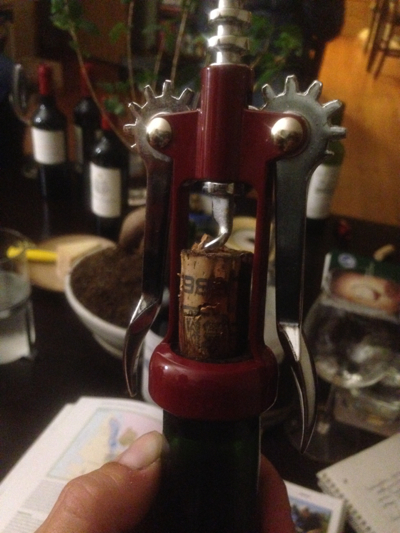Highly Classified Information
How important is the classification of Bordeaux wines?
In WSET on 14 May 2017
With my WSET Diploma Unit 3 exam looming in the not-so-distant future, I’ve been practicing writing essays on a variety of wine industry topics, and friends suggested I post them here. The countdown has begun, and it’s time for daily review starting with Bordeaux. Today’s question: What are your views on the classification of Bordeaux wines?

While my customers understand that Cru Classé Bordeaux wines are special, important, and above all expensive, few of them understand why.
In my role as a wine educator I work with wine beginners for the most part, most of whom could tell you the grapes in Bordeaux but probably not explain what the 1855 classification was or what it can tell us today. If they asked––and they typically don’t; I don’t see a lot of interest in classified Bordeaux from my customers because they see it as overpriced and inaccessible, and their interests lie toward the opposite––here’s what I’d tell them.
The 1855 classification is, today, a surprisingly reliable indicator of price, which was its chief initial criterion, and quality––if we look simply at scores. First and second growths, especially, are outrageously expensive and typically highly rated enough to suggest that they remain the benchmark in quality for the rest of the world.
I’ve had the pleasure of tasting a single First Growth in my life, a 1989 Haut-Brion, and it was absolutely the transcendent wine experience I expected, but otherwise my experience tasting anything other than second wines of great châteaux has been quite limited in my corners of the wine industry. High-end Bordeaux just doesn’t get opened very often for buyers or customers, and the trade doesn’t pay the kind of money that would allow most of us to collect them on our own these days.
With the caveat that many Second and Third Growths are commanding prices as high as or higher than the First Growths, thanks to scores and press, I see classification and scores (both professional and crowdsourced via sites like Cellartracker) together as, really, the only guiding light most consumers have by which to navigate; when your trusted shopkeeper hasn’t tasted a $500 bottle of wine, you have to rely on something to determine whether to buy it.
So how easy is Bordeaux classification to understand? I can at least say that the 1855 classification is probably straightforward enough for an American consumer: first, second, and so on, ranked by château rather than vineyard. I think you have a better sense of what you’re getting with a classified Médoc wine, where you need only research the château itself, than a Premier Cru Burgundy, where knowing the vineyard and knowing the producer are equally important to selecting a good bottle and the prices are equally astronomical.
But the Saint-Emilion and Cru Bourgeois classifications and the AOC system must all be understood too in order to understand Bordeaux. Here I wish there was some consistency: Saint-Emilion is reevaluated every ten years; Cru Bourgeois has had a terribly confusing history with a ranking system with the classification established and then dismantled; AC Entre-Deux-Mers can only be white even though both white and red grapes are grown in the region (the red wines are typically just labeled Bordeaux AC). Bordeaux classification demands considerable knowledge from the consumer even by French standards due to these regional inconsistencies. If we were to streamline them somehow, I like the regular reevaluation concept, since it allows up-and-coming châteaux to gain recognition and prevents originally classified houses from resting on their laurels. It’s absolutely outrageous, when you think about it, that we’re buying (or, more likely, not buying) most of the best Bordeaux based on what houses commanded the highest prices in 1855, before phylloxera, countless changes of ownership, and swinging market trends.
As for me in my own purchasing, I like to research the lesser-known producers whose wine is most likely to overdeliver due to a stellar vintage or new, more quality-driven ownership; classification doesn’t help me much there. If I had the kind of money it takes to taste through more expensive Cru Classé Bordeaux, I’d ask around among my colleagues for suggestions, then supplement that with both Cellartracker (a way to crowdsource thoughts from the general populace rather than wine authorities, which can be especially helpful when determining how a certain vintage is drinking now) and scores from the writers I trust to make my purchasing decisions. For Saint-Emilion wines, I might pay a little more attention to classification since those are reevaluated every 10 years, but I would still not consider classification a primary indicator for whether a wine will deliver because of how much can change at a winery in 10 years in terms of ownership, climate, and response to consumer demands.
I am especially interested in the question of the role of classification as climate change and consumer tastes in growing markets like China become even more of an influence in Bordeaux. Will a warming climate cause more near-perfect vintages, allowing more châteaux to reach the level of the 1855s––thus rendering the original classifications largely irrelevant? Will China’s trend away from classified Bordeaux continue as entry-level consumers become more interested in wine, and how else will their market demands change? And if these come to pass, who will invest in the First Growths, and will it pay off?
I suspect classifications will continue to remain in place long after their importance begins to fade––if it already hasn’t–– since rules change slowly in the wine world and especially in France. But I also think they self-perpetuate. Until more people have an opportunity to taste Bordeaux, it will always be an investment-oriented wine industry, and investors need solid predictions, so as long as classifications correspond to market prices they will surely stay important on the business end of this industry.